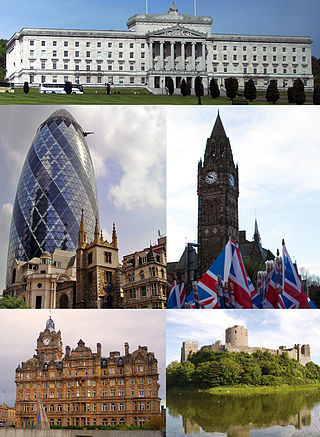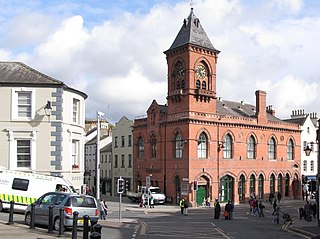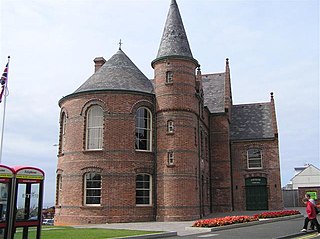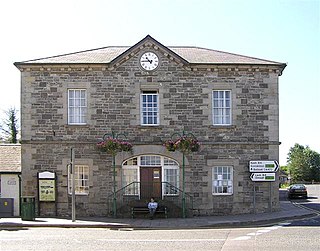
Newtownards is a town in County Down, Northern Ireland. It lies at the most northern tip of Strangford Lough, 10 miles (16 km) east of Belfast, on the Ards Peninsula. It is in the civil parish of Newtownards and the historic baronies of Ards Lower and Castlereagh Lower. Newtownards is in the Ards and North Down Borough. The population was 29,677 in the 2021 Census.

Clones is a small town in the west of County Monaghan in Ireland. The area is part of the Border Region in the Republic of Ireland, earmarked for economic development by the Irish Government due to its currently below-average economic situation. The town was badly hit economically by the Partition of Ireland in 1921 because of its location on the border with County Fermanagh in Northern Ireland. The creation of the Irish border deprived it of access to a large part of its economic hinterland for many years. The town had a population of 1,885 at the 2022 census. The town is in a civil parish of the same name.

Monaghan is the county town of County Monaghan, Ireland. It also provides the name of its civil parish and Monaghan barony.

Saintfield is a village and civil parish in County Down, Northern Ireland. It is about halfway between Belfast and Downpatrick on the A7 road. It had a population of 3,588 in the 2021 Census, made up mostly of commuters working in both south and central Belfast, which is about 18 km away. The population of the surrounding countryside is mostly involved in farming.

Stewartstown is a village in Northern Ireland, close to the western shore of Lough Neagh, about 5 miles (8 km) from Cookstown, 3 miles (5 km) from Coalisland and 7 miles (11 km) from Dungannon. Established by Scottish Planters early in the 17th century, its population peaked before the Great Famine of the 1840s at over 1000. In the 2011 Census the town had a population of 650 people. Formerly in the historic County Tyrone, today it is in local-government district of Mid Ulster.
Sir Charles Edward Bainbridge Brett, KBE, CBE, was a Northern Irish solicitor, journalist, author and founding member, and first chairman, of the Ulster Architectural Heritage Society (UAHS). He was known to many simply as Charlie Brett.

Killeshandra or Killashandra, is a small town or village and civil parish in County Cavan, Ireland. Killeshandra is located 20 kilometres (12 mi) west of Cavan Town and is a "gateway" to the UNESCO Cuilcagh Lakelands Geopark region, part of the Erne catchment environment of rivers, lakes, wetlands and woodland. Together with the Lough Oughter Special Protected Area (SPA), it has been recognised by the EU programme for wildlife, Natura 2000, since 2010.
Ulster Architectural Heritage Society was founded "to promote appreciation and enjoyment of good architecture of all periods and encourage the conservation, restoration and re-use of Ulster's built heritage to regenerate and sustain our communities".

Portnablagh is a small village in County Donegal in Ulster, the northern province in Ireland. Portnablagh is located on the north-west coast of County Donegal, specifically the west side of Sheephaven Bay. It is on the N56 road.

The architecture of the United Kingdom, or British architecture, consists of a combination of architectural styles, dating as far back to Roman architecture, to the present day 21st century contemporary. England has seen the most influential developments, though Ireland, Scotland, and Wales have each fostered unique styles and played leading roles in the international history of architecture. Although there are prehistoric and classical structures in the United Kingdom, British architectural history effectively begins with the first Anglo-Saxon Christian churches, built soon after Augustine of Canterbury arrived in Great Britain in 597. Norman architecture was built on a vast scale throughout Great Britain and Ireland from the 11th century onwards in the form of castles and churches to help impose Norman authority upon their dominions. English Gothic architecture, which flourished between 1180 until around 1520, was initially imported from France, but quickly developed its own unique qualities.

Lisburn Courthouse is a judicial facility in Railway Street in Lisburn, County Antrim, Northern Ireland. It is home to the magistrate's and county courts.

Market House is a municipal building in Conway Square, Newtownards, County Down, Northern Ireland. It is a Grade B+ listed building.

The Down Arts Centre, formerly Downpatrick Town Hall and also Downpatrick Assembly Rooms, is a municipal structure in Irish Street in Downpatrick, County Down, Northern Ireland. The structure, which was the meeting place of Down Urban District Council, is a Grade B1 listed building.

The Old Town Hall is a municipal structure in Scarva Street in Banbridge, County Down, Northern Ireland. The structure, which currently accommodates a Community Advice Centre on the ground floor and a room for local community groups on the first floor, is a Grade B1 listed building.

Ballyclare Town Hall is a municipal structure in The Square, Ballyclare, County Antrim, Northern Ireland. The structure, which is primarily used as an events venue, is a Grade B2 listed building.

Portrush Town Hall is a municipal structure in Mark Street, Portrush, County Antrim, Northern Ireland. The structure, which is used as an events venue, is a Grade B+ listed building.

Ederney Town Hall, also styled as Ederney Townhall, is a municipal structure in Market Street, Ederney, County Fermanagh, Northern Ireland. The structure, which is used as a community events venue, is a Grade B1 listed building.

Ballynahinch Market House, formerly known as Ballynahinch Court House and as Ballynahinch Town Hall, is a municipal structure in the Market Square, Ballynahinch, County Down, Northern Ireland. The structure, which is used as a community events venue, is a Grade B1 listed building.

The War Memorial Building is a grade B2 listed building in Belfast, Northern Ireland. The building, modernist in design, was constructed in 1959–1962 on the site of a hotel destroyed during the 1941 Belfast Blitz. The building was formally opened by Queen Elizabeth The Queen Mother and housed organisations and charities related to the British armed forces. The site currently lies empty and has been placed on the Heritage at Risk Register. The current owners have applied for permission to convert the building into a 120-bedroom hotel.


































